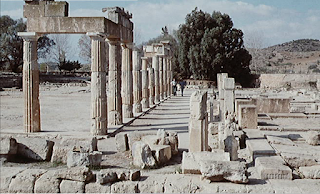
You can’t really go wrong with Peter Cushing, so expressively constrained he carries menace or blessed determination with him as two sides of an innately-intense dichotomy that makes him compel even in the mildest of films. So powerful is the Cushing aura that it even works over a distance of forty years and, as recently seen, in CGI form.
In this film, also known as Land of the Minotaur, he is let down by a pedestrian script and some
reptilian directing from Kostas Karagiannis even though there is still plenty
to entertain. The screen is as sun-bleached as the parched locations and the
pace a strength-sapping climb in arid Grecian hills but events are enlivened by
an interesting electronic score from Brian Eno as well as the tight-fit
presence of Luan Peters.
 |
| Donald Pleasence and the magnificent Luan Peters |
A couple of western tourists have vanished under
mysterious circumstances… well, mysterious to the Father but we’ve already seen
their ritual slaughter before the title credits, as mysteries go this is more Columbo than Murder She Wrote. The priest is convinced it’s the return of an
ancient evil and, unable to trust the local police - Fernando Bislamis is great
as Sgt Vendris: an officer with so many things on his mind… calls on a favour
from an old friend.
 |
| Jane Lyle and Kostas Karagiorgis |
 |
| Vanna Reville, Nikos Verlekis and Donald |
They present Father Roche with an old ring with the image
of a Minotaur cast on it but he tries to put them off investigating the
location where it was found: there’s danger there he knows it.
Will they listen? Will they heck… Off they scoot in the mystery machine and set up camp on the edge of a foreboding walled town up in the mountains… The following Beth takes the combi and her short-shorts into the village to buy some provisions. She is briefly held spellbound by a strange child in the store, whilst her pants have a similar effect on male shoppers.
Outside, struggling with her shopping and her mighty
mid-seventies platform shoes, she meets an even stranger presence in the form
of Baron Corofax (Peter Cushing) who charms her immediately with his serpentine
stare and easy charm. Cushing conveys so much evil intent even as he smiles at
the young woman casting his eyes heavenward as if in challenge to his master’s
ultimate enemy. The Baron presents as trustworthy old money but all his
chivalry is masking something unpleasant and as Beth smiles sweetly in her
suddenly vulnerable hipster clothing we know she’s in for trouble.
 |
| The Baron, the kombi-van and the shorts... |
Cut to someone new as another jet brings in Laurie Gordon
(Luan Peters) in search of her missing boyfriend… she joins the priest and the
private eye and the three drive out to the mysterious town where the young
white couples have gone a-missing. There’s a bit of funny about Milo’s driving
– New York minutes past too fast for Father Roche and soon they are mingling
with the sinister villages, their something to hide attitudes clear for all to
see.
 |
| Donald, Luan and Kostas |
The trio stay at the local inn – home to the starey-eyed
girl and her nervous father. It’s been a long dusty trip and so, hooray, Laurie
decides to have a bath! This is good news for so many men of my age and the
sight of Luan Peters in bubble-bath is not at all gratuitous as it allows the
director to illustrate her vulnerability, which is, after all, next to
clenliness… a window creaks and hooded faces look through, seven levels of
moral perversions on their mind. Milo arrives to find Laurie fainted and
steadfastly refuses to believe her story… got to string this one out a little
further.
So, in the interests of plot exposition, perhaps it’s a
good thing that Laurie is next to vanish, carelessly left behind as the players
align and this all boils down to a battle between the Baron and the Priest and
Milo’s humanistic brute force against the hooded hoards’ pagan force.
 |
| The fearless Minotaur cult hunters |
Dusty Verdict:
The Devil’s Men is worth a look for
sunshine, Luan and the two old masters but the story is a little lacking in
impact. Almost every move is telegraphed from Milo’s hackneyed Greco-Manhatten
attitudes to the inevitability of those sacrificed and even those saved.
Kostas Karagiannis directs with a deliberate hand and,
whilst there are some good moments, these are never sustained and in the end
everything is a just little too neat. Cushing and Pleasence do their best but
there’s precious little for Luan to do other than scream, take a bath and wear
the most outrageously tight white trousers, whilst Kostas Karagiorgis fires off
one liners with as little effect as his bullets against the Minotaur’s
followers.
 |
| Donald Pleasence |






















No comments:
Post a Comment